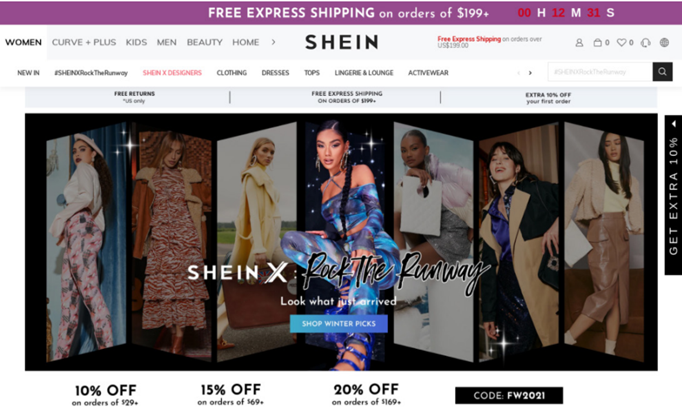Inside Shein’s Revolutionary Fast-Fashion Business Model
Trend Spotlight from RI 2022: Shein Reinvents Fast Fashion through Extensive Test and Learn Approach
This week we are highlighting an innovative business from our recently published RI 2022 section entitled Engagement Out-of-store, which includes companies that innovate outside of a physical store leveraging tactics such as livestream shopping, unboxing experiences, influencer marketing, and virtual shopping experiences.
We previously discussed the winner selected for this category – Walmart X Mashable. Today we highlight Shein, a Nanjing, China-based company that has taken the global fast fashion industry by storm. Read on for a review of Shein’s innovative business model, which relies on a nimble and data-driven digital customer engagement strategy.
A Decade of Explosive Growth
Shein is one of the fastest-growing direct-to-consumer companies in the world, surpassing Amazon in the US as the top shopping app downloaded by consumers in the spring of 2021, and achieving more than 100% growth during each of the last eight years. Founded in 2008, Shein has reportedly reached annual sales of nearly $16B USD and a valuation estimated at $50B USD as of last year. Shein ships its fast fashion merchandise to over 220 countries and regions worldwide, and just this week announced it is investing $2.3B USD in a global supply chain hub in Guangzhou to support its global growth. This new fashion behemoth caters to a Generation Z customer though partnerships with influencers on TikTok and Instagram, offering products sourced directly from small and large Chinese factory producers, and focusing on extreme trendiness, innovation, and low-cost merchandise.
On its customer-facing pages, Shein effectively captures its target customer’s attention through a sleek customer experience, appealing visuals and gamified rewards, and social media partnerships and social selling. However, none of this would be possible without unprecedented levels of data science sophistication and supply chain control behind the scenes.
Becoming Friends with Factories
From its inception, Shein has cultivated close relationships with a network of several thousand Chinese fashion producers and suppliers, leveraging its geophysical proximity and securing top priority by always paying on time. In return, these suppliers give Shein preferential treatment, allowing them to request much smaller-than-normal style runs with a very quick turnaround. Through this relationship, the brand consistently beats competitors on price and reportedly adds 2,800 new styles to its site each week on average, a number much higher than its competitors can match.
Data-science Integrated into Business Processes
Shein then leverages its data-science sophistication to track to customer engagement with its new products through a Large Scale Automated Testing and Reordering (LATR) System. This system tracks performance across its thousands of new products, and automatically reorders winners while also spotting overarching fashion trends. Customers are treated to an exciting and sticky “treasure hunt” experience where they are constantly presented with new and compelling products. Meanwhile, Shein ensures it is only reordering products that have a high probability of succeeding, thereby keeping warehousing costs low, sell-through high, and passing the savings along to the consumer. This creates a virtuous cycle where more relevant products create more consumer demand, more demand feeds the model more data, and Shein leverages this additional data to provide an even more compelling offer.
Like any algorithmically-driven business model with tens of thousands of products, Shein faces significant challenges overseeing and controlling what products are elevated on their marketplace, and has faced several PR embarrassments as a result. Fast fashion in general has also faced widely publicized criticism for the high levels of waste inherent in these business models. Aligning its business practices with consumer values will likely be one of Shein’s largest challenges as it continues to expand.

Photo Credit: Shein
Why We are Inspired
Shein has built their entire business around effectively harnessing consumer demand, from trend, to design, to production, to distribution. Underlying the brand’s incredible global growth story is a production cycle that experts believe has been compressed into one week. Shein’s network of factory suppliers first produce small batches of as little as 100 new potential items, and production is rapidly scaled up only after proving out consumer demand. Shein’s supply-chain management software allows the company to monitor the production process and share customer data with suppliers to guide design and production. Shein has utilized its data science to garner a deep knowledge of their consumer to understand how to best attract them through trend-right product and engagement via relevant social influencers. The brand is approaching the customer in new ways, using influencers for customer acquisition and to drive demand.
Stay tuned as we continue highlighting inspiring examples from each of our five key trend areas in the coming weeks. Follow along with us on our blog and our Instagram feed and stories.
Download Your Copy of Retail Innovations 2022 here.

No Comments